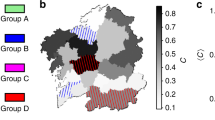Abstract
In this article, we present a mathematical model of a unilingual society developing in to a bilingual society. We formulate, analyze the model and interpret the results of the analysis. The model is based on a two language policy motivated by the cultural and historical back ground of India.
Similar content being viewed by others
References
I. Baggs and H.I. Freedman, A mathematical model for dynamical interpretations between a unilingual and bilingual population: Persistence Vs. extinction, J. Math. Sociology, 16(1990), 51–75.
I. Baggs and H.I. Freedman, Can speakers of a dominated language survive as unilinguals? A mathematical model of bilingualism, Math. Comput. Modeling, 18(1993), 9–18.
E.A. Barbashin, The construction of Lyapunov functions, J. Diff. Eqns., 4(1968), 1097–1112.
S. Lieberson, Forces affecting language spread: some basic propositions, In language spread: Studies in Diffusion and Social Change (Ed., R.L. Cooper), Bloomington, Indiana University Press, 37–62.
W.F. Mackey, The description of bilingualism, In Readings in Sociology of Languages (Ed., J.A. Fisherman), Mouton, The Hague, 1972.
W.F. Mackey, “ Bilingualism as a World Problem”, Harvard House, Montreal, 1976.
K.D. McRae, “ Conflict and Compromise in Multilingual Societies: Switzerland”, Wilfred Laurier University Press, Waterloo, Ontario, 1983.
M.J. Norris and R.D. Driver, A uniqueness theorem for ordinary differential equations, SIAM J. Math. Anal., 12(1981), 141–144.
P.G. Sharma and S. Kumar, “ Indian Bilingualism”, Kendriya Hindi Samsthan, Agra, India, 1977.
V. Sree Hari Rao and P. Raja Sekhara Rao, Stability analysis of ratio-dependent prey-predator models, Nonlinear Analysis:Real World Applications, 6(2005), 245–262.
V. Sree Hari Rao and P. Raja Sekhara Rao, Mathematical models and stabilizing bio-control mechanisms for microbial populations in a cultured environment, Chaos, Solitons and Fractals, 28(2006), 1222–1251.
Author information
Authors and Affiliations
Corresponding author
Additional information
Formerly University of Missouri, Rolla
On leave from Jawaharlal Nehru Technological University, Hyderabad- 500 085, India.
This research is supported by a grant from the Foundation for Scientific Research and Technological Innovation (FSRTI) — A Constituent Division of Sri Vadrevu Seshagiri Rao Memorial Charitable Trust, Hyderabad — 500 035, India.
Rights and permissions
About this article
Cite this article
Sree Hari Rao, V., Raja Sekhara Rao, P. Dynamical models for the development of unilingual society into bilingual society. Differ Equ Dyn Syst 16, 29–45 (2008). https://doi.org/10.1007/s12591-008-0003-5
Received:
Accepted:
Published:
Issue Date:
DOI: https://doi.org/10.1007/s12591-008-0003-5




